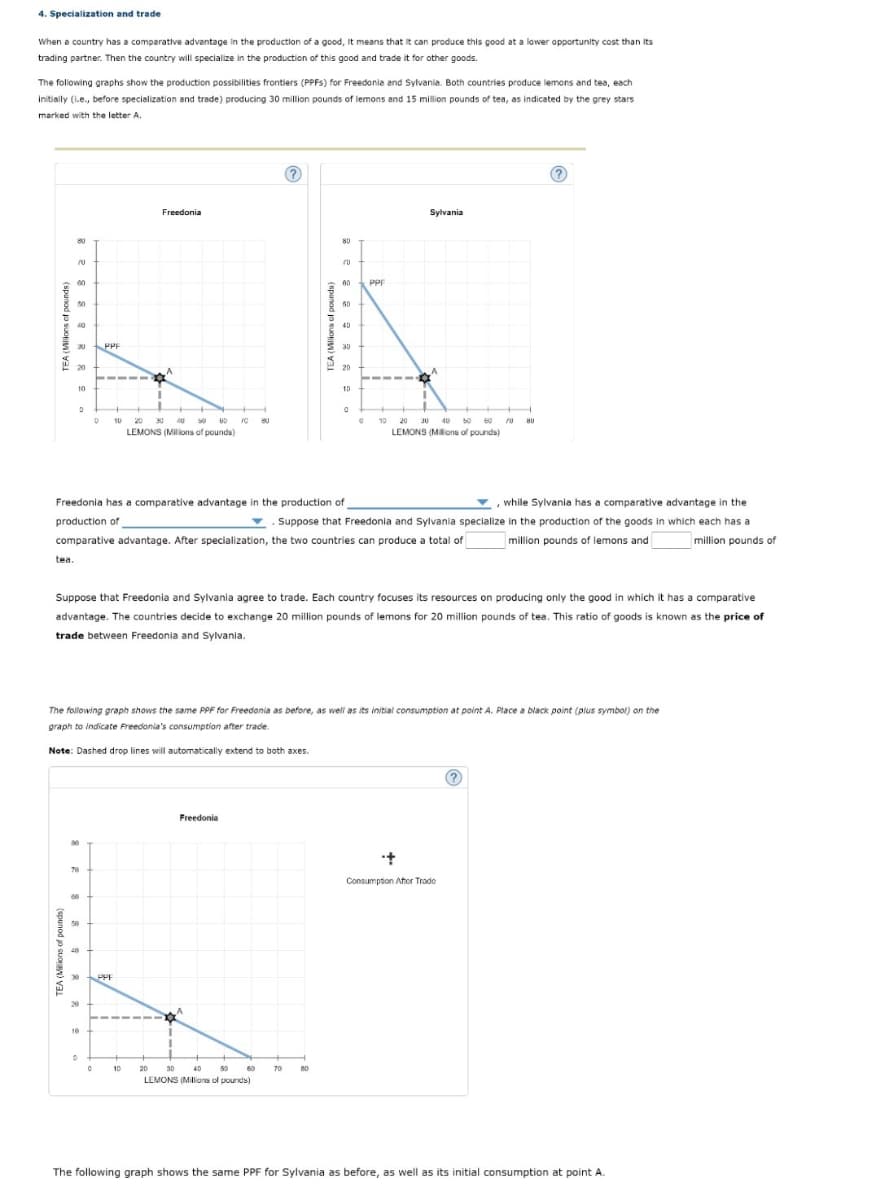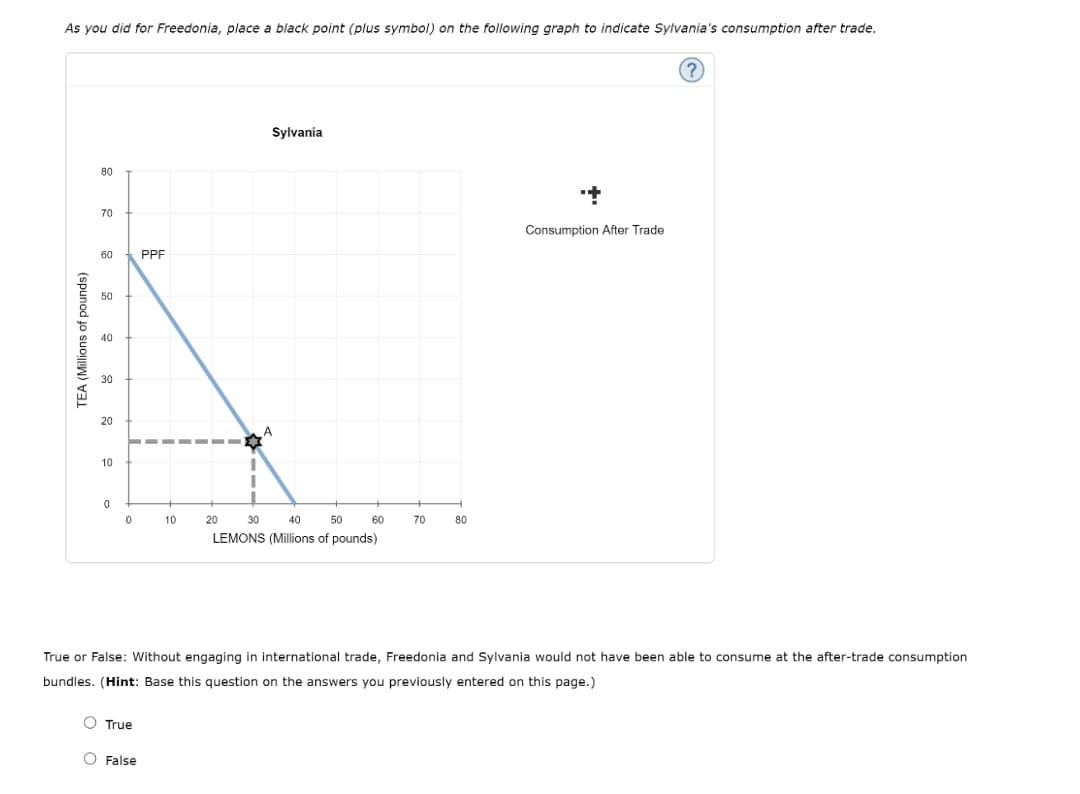Freedonia has a comparative advantage in the production of production of , while Sylvania has a comparative advantage in the Suppose that Freedonia and Sylvania specialize in the production of the goods in which each has a comparative advantage. After specialization, the two countries can produce a total of million pounds of lemons and million pounds of tea. Suppose that Freedonia and Sylvania agree to trade. Each country focuses its resources on producing only the good in which it has a comparative advantage. The countries decide to exchange 20 million pounds of lemons for 20 million pounds of tea. This ratio of goods is known as the price of trade between Freedonia and Sylvania.
Freedonia has a comparative advantage in the production of production of , while Sylvania has a comparative advantage in the Suppose that Freedonia and Sylvania specialize in the production of the goods in which each has a comparative advantage. After specialization, the two countries can produce a total of million pounds of lemons and million pounds of tea. Suppose that Freedonia and Sylvania agree to trade. Each country focuses its resources on producing only the good in which it has a comparative advantage. The countries decide to exchange 20 million pounds of lemons for 20 million pounds of tea. This ratio of goods is known as the price of trade between Freedonia and Sylvania.
Chapter4: The Aggregate Economy
Section: Chapter Questions
Problem 4E
Related questions
Question
100%
Practice Pack

Transcribed Image Text:4. Specialization and trade
When a country has a comparative advantage in the production of a good, It means that it can produce this good at a lower opportunity cost than Its
trading partner. Then the country will specialize in the production of this good and trade it for other goods.
The folowing graphs show the production possibilities frontiers (PPFS) for Freedonia and Sylvania. Both countries produce lemons and tea, each
initially (i.e., before specialization and trade) producing 30 million pounds of lemons and 15 million pounds of tea, as indicated by the grey stars
marked with the letter A.
Freedonia
Sylvania
80
80
00
60
PPE
60
of
* 40
40
30
PPF
S 30
20
쁘
20 +
-----
10
10
30 40 s0
LEMONS (Milions of pounds)
O 10
LEMONS (Mlons of pounda)
60
80
20 30 40 50
80
Freedonia has a comparative advantage in the production of
, while Sylvania has a comparative advantage in the
production of
v. Suppose that Freedonia and Sylvania specialize in the production of the goods in which each has a
comparative advantage. After specialization, the two countries can produce a total of
million pounds of lemons and
million pounds of
tea.
Suppose that Freedonia and Sylvania agree to trade. Each country focuses its resources on producing only the good in which it has a comparative
advantage. The countries decide to exchange 20 million pounds of lemons for 20 million pounds of tea. This ratio of goods is known as the price of
trade between Freedonia and Sylvania.
The following graph shows the same PPF for Freedonia as before, as wel as its initial consumption at point A. Place a black point (plus symbol) on the
graph to indicate Freedonia's consumption after trade
Note: Dashed drop lines will automatically extend to both axes.
Freedonia
70
Consumption Afor Trado
50
30
PPF
20
10
10
20 30 40
50
60
70
80
LEMONS (MIlliona ol pounds)
The following graph shows the same PPF for Sylvania as before, as well as its initial consumption at point A.

Transcribed Image Text:As you did for Freedonia, place a black point (plus symbol) on the following graph to indicate Sylvania's consumption after trade.
Sylvania
80
70
Consumption After Trade
60
PPF
50
40
30
20
10
20
30
40
50
60
70
80
LEMONS (Millions of pounds)
True or False: Without engaging in international trade, Freedonia and Sylvania would not have been able to consume at the after-trade consumption
bundles. (Hint: Base this question on the answers you previously entered on this page.)
O True
O False
TEA (Millions of pounds)
Expert Solution
This question has been solved!
Explore an expertly crafted, step-by-step solution for a thorough understanding of key concepts.
This is a popular solution!
Includes step-by-step video
Trending now
This is a popular solution!
Learn your way
Includes step-by-step video
Step by step
Solved in 2 steps with 1 images

Knowledge Booster
Learn more about
Need a deep-dive on the concept behind this application? Look no further. Learn more about this topic, economics and related others by exploring similar questions and additional content below.Recommended textbooks for you


Principles of Economics 2e
Economics
ISBN:
9781947172364
Author:
Steven A. Greenlaw; David Shapiro
Publisher:
OpenStax


Principles of Economics 2e
Economics
ISBN:
9781947172364
Author:
Steven A. Greenlaw; David Shapiro
Publisher:
OpenStax